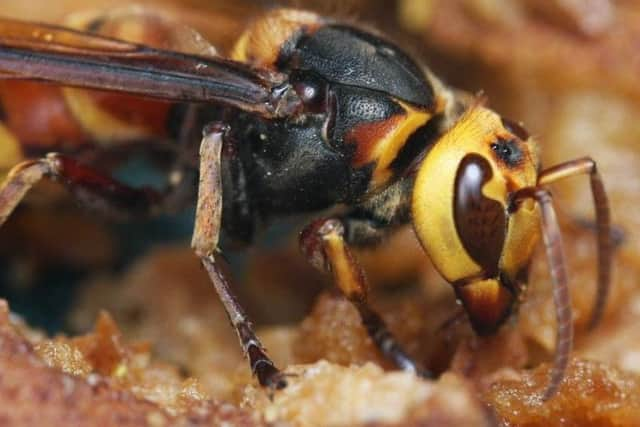Huge deadly Asian Hornet nest in the Channel Islands has been discovered
The huge nest with at least 200 Asian Hornet queens all capable of creating colonies was discovered on the tiny island of Sark.
The fight is on-going on the Channel Island and is seen as a crucial battle-ground to stop the spread to Britain.
Advertisement
Hide AdAdvertisement
Hide AdJust one of the foreign menaces can eat up to 50 bees a day and their impact on honey production could be devastating.


The Asian Hornet Team have spent months researching and talking to beekeepers all over the UK, recording nest locations and sightings.
And they spent several weeks trying to track down the huge Sark nest which measured 45cm wide and was 50cm tall.
The beekeepers have now returned to the islands to destroy it after they were able to single out the base of a chestnut tree as the source.
In late summer, Francis Russell and Damian Harris first went across to Sark to begin tracking down the nest.
Unfortunately, they struggled to locate the nest and put up bait stations and 'loosely' triangulating its location.
Francis Russell, project coordinator for the team, said: "The size of the nest there could be over 200 queens that have been prevented from continuing to exist on Sark.
"And in the ten or so traps placed around the nest we caught a further 300 hornets.
Advertisement
Hide AdAdvertisement
Hide Ad"When the queen comes out of hibernation she builds a small nest and raises a small band of workers 30-50 - the nest that she has built herself is called a primary, or first nest.
"Later on when the workers then take over building the nest it becomes much larger and gets progressively bigger over the summer/autumn."
The nest was so large that by removing it, the team have prevented at least 200 Asian hornet queens from creating colonies.
Francis added: "It can be very large, containing 5,000 hornets or more, usually found up in the tree tops.
"These larger nests are called secondary - it is the main nest from which the new queens are raised.
"The one on Sark was a typical large secondary nest although unusually it was low down in brambles."
The Asian Hornet Team were aware of the nests on Sark and had been notified of at least 20 sightings over the course of this year.
Francis added: "There had been about 10 queens sighted around Sark in the spring and even one which was found to have drowned in someone's pint of beer.
Advertisement
Hide AdAdvertisement
Hide Ad"We noticed a 10-week period in which there were no sightings on Guernsey but repeated sightings on Sark over June time.
"If there are hornet sightings in June this means that a queen has rested somewhere."
Now, Francis and Damian have returned to the island and removed the massive nest.
Francis added: "Damian and I travelled over again on Wednesday to remove the nest on request of the Sark Agriculture Department.
"Damian treated the nest with pesticide and then we returned four hours later to cut it away.
"It was double bagged and has now been returned to Raymond Falla House for dissection and analysis.
"At this point in time we are just trying to work out what we have found. The size of it there could be at least 200 queens prevented from building more nests."
The species, which began to spread through Europe in 2004 after arriving in the south of France inside a freight ship, was first spotted in Jersey in late 2016.
Since then, the number of nests has been growing year on year.
The invasive insects prey on bees and eat as many as 50 a day, and are considered a threat to other pollinators.
